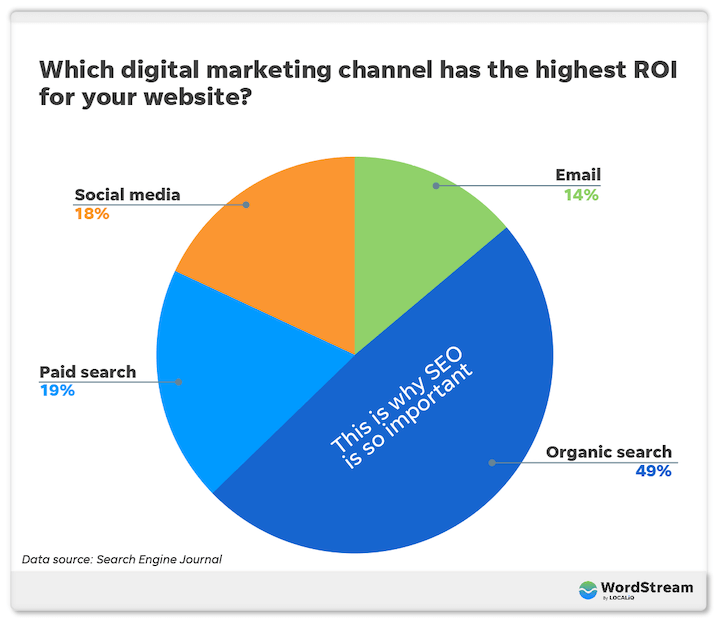
Google, the world’s leading search engine, currently has over 85% of the search engine market. And, they’ve made it abundantly clear that their ranking preferences lean heavily towards websites that prioritize user experience.
This means they reward content that resonates with an audience, demonstrates expertise, and adds tangible value to the lives of readers.
As a B2B business, consistently sharing fresh content isn’t just a recommendation; it’s a necessity. But how exactly does fresh content impact your SEO? And more importantly, how can you streamline your content creation process to ensure a consistent flow of fresh content?
In this post, we’re exploring the role of fresh content in SEO, its impact on SEO marketing, and practical strategies you can implement to keep your content fresh and engaging.
Quick Takeaways
- According to Search Engine Journal, 49% of marketing professionals deemed organic search as their most profitable marketing channel.
- Fresh content improves search rankings, increases engagement, establishes trust, optimizes keywords, and earns backlinks.
- Updating and republishing outdated blog posts with new information and images can increase organic traffic by as much as 106%.
- Content marketing agencies have the expertise and resources to create high-quality content that aligns with your business’s goals.
The Role of Fresh Content in SEO
Just like how viewers expect to see new stories and updates on the news every day, your audience and search engines expect to see new information on your website regularly. This new information is what we call “fresh content”. This could be anything like:
- Brand-new blog posts
- Articles
- News updates
- Revised landing pages
According to Search Engine Journal, 49% of marketing professionals deemed organic search as their most profitable marketing channel. But in order to reap the benefits of organic search, first you need to rank on SERPs.

Image Source: Search Engine Journal
Adding fresh content to your website regularly is like telling your audience and the search engines, “Hey, we’re still here, and we’ve got new things to share!” As a result, it keeps your website relevant and improves your visibility on SERPs.
The Significance of Fresh Content
Search engines, like Google, have a preference for new and updated content.
When a website regularly publishes new articles, modifies existing ones, or adds new resources, it signals to search engines that the site is active and current.
Audience Engagement
Fresh and frequent content also plays a pivotal role in audience engagement.
Regular updates provide a continuous stream of new information for your audience, encouraging repeat visits and increased interaction.
This not only helps to establish your brand as a trusted authority in your field but also improves your search engine rankings.
The Importance of Frequency
The impact on SEO isn’t just about having fresh content; the consistency of updates is equally as important.
A recent study shows that companies publishing at least 4 blog posts per week saw 3.5 times the traffic compared to companies publishing only once per week.

Regularly updating your site indicates reliability, which search engines value highly.
Opportunities for Keyword Integration
Each new piece of content presents an opportunity to incorporate relevant keywords, which can improve your visibility for specific search queries.
Just keep in mind that the goal isn’t to overload your content with keywords, but rather to seamlessly integrate them into high-quality, engaging content.
The Effect of Fresh Content on SEO Marketing
For B2B brands specifically, consistently posting fresh content isn’t just a good practice; it’s a strategic move that can significantly enhance your SEO, increase your visibility, and ultimately drive more business through:
- Improved search engine rankings. Search engines favor websites that regularly update with fresh content. As a result, your site is more likely to achieve higher rankings in search engine results.
- Increased engagement. Fresh content keeps your audience engaged by providing them with new information, insights, and resources. This consistent engagement can lead to higher traffic, more time spent on your site, and more shares on social media.
- Authority and trust. Regularly publishing high-quality, fresh content helps establish your brand as a thought leader in your industry. This can build trust with your audience and search engines alike, which can boost your search engine rankings.
- Keyword optimization. Each new piece of content is an opportunity to weave in relevant keywords that your target audience is searching for. This can help you rank higher for those specific search queries.
- Link building. Fresh content can attract more backlinks from other websites. These backlinks are a key factor that search engines consider when ranking websites. In fact, the #1 result on Google has an average of 3.8x more backlinks than positions #2-#10. So, the more high-quality backlinks you have, the better your SEO.
How To Post Fresh Content Consistently
You’re probably wondering, “How am I going to find the time to crank out fresh content consistently?”
The truth is that posting fresh content consistently is manageable when you have the right tool and strategy in place. Here’s a few key strategies that can help keep your content fresh and improve your SEO, while minimizing your time commitment.
1. Update Old Content
Your content can become outdated or irrelevant over time, and search engines like Google reward content that is current and provides value to users.
Updating and republishing outdated blog posts with new information and images can increase organic traffic by as much as 106%. And according to Databox, 67% of marketing experts are updating old content.

Image Source: Databox
By updating old content, you’re not only improving its relevance, but also signaling to search engines that your site is active.
Here’s how you can get started:
- Identify content for updates. Start by identifying which pieces of content could benefit from an update. These could be articles that are outdated, have declining traffic, or no longer align with your current business goals.
- Add new information. Once you’ve identified the content, look for ways to add new information. This could be recent industry developments, updated data, or new insights that weren’t available when the content was first published.
- Revise outdated information. Remove or revise any information that’s no longer accurate. This could be outdated statistics, old product information, or broken links.
- Improve SEO. Take this opportunity to improve the content’s SEO. This could involve adding relevant keywords, improving meta descriptions, or optimizing images.
- Republish. Once you’ve updated the content, don’t forget to republish it. This will bring it back to the top of your blog or news feed, giving it more visibility.
Not only does this process keep your content relevant and improve your SEO, but it’s also a lot quicker than creating fresh content from scratch.
2. Make a Content Calendar
A content calendar is a schedule that outlines when and what you’ll publish in the future. It’s a vital tool for planning your content strategy and making sure that you’re regularly publishing new content.
Creating a content calendar might seem daunting, but it streamlines the creation process, making your content more efficient and effective. In the simplest terms, all you need to do is:
- Identify and understand your content needs
- Plan your topics
- Schedule your content
- Assign responsibilities
- Track your progress
To follow our step-by-step process for creating a content calendar, read our post on “How to Make a Content Calendar You’ll Actually Use.”
3. Collaborate with a Content Marketing Agency
Creating fresh, engaging content on a regular basis isn’t easy, especially if you have limited resources or expertise in-house.
Content marketing agencies have the expertise and resources your business needs to create high-quality content that aligns with your goals and resonates with your audience. Not to mention, it takes the “create new content” task off your to-do list, giving you more time to focus on other areas of your business.
When you collaborate with a content marketing agency, you can:
- Maintain a consistent flow of fresh content
- Leverage your agency’s expertise
- Boost SEO
- Reach your target audience
- Rely on professional writers

Image Source: Literal Humans
The perks of working with a content marketing agency don’t stop there. Read more in our “What Is a Content Marketing Agency and Why Do You Need One?” article.
4. Use Content Creation Tools
Content creation tools can simplify the process of creating fresh content. They can help you generate ideas, organize your content, optimize your SEO, and even automate the publishing process.
There are a ton of content creation tools out there, each with its own set of features. Here’s a few suggestions:
- Idea generation. BuzzSumo or AnswerThePublic can help you generate content ideas based on popular trends or commonly asked questions in your industry.
- Content organization. Trello or Asana can help you organize your content, track your progress, and manage your content calendar.
- SEO optimization. SEMrush or Yoast can help you optimize your content for SEO by suggesting keywords, analyzing your readability, and providing SEO recommendations.
- Content creation. Hemingway Editor or Grammarly can help in creating visually appealing graphics or ensuring your content is grammatically correct and well-written.
- Distribution. Buffer or Hootsuite can automate the process of publishing your content on various platforms at scheduled times.
Using content creation tools can save you time, improve the quality of your content, and make sure that you’re consistently publishing new content.
5. User-Generated Content
User-generated content refers to any content–text, videos, images, reviews, etc.–created by people, rather than brands.
UGC can be a powerful tool for B2B brands because it adds authenticity to your content and can help build trust with your audience. Plus, it provides a steady stream of fresh content without calling in all of your resources.
Video Source: Inbound Explained
Here’s a few ways B2B brands can leverage user-generated content:
- Encourage reviews and testimonials. Ask your clients to write reviews or testimonials about your products or services. You can feature these on your website or social media platforms.
- Host contests or giveaways. Encourage your audience to create content related to your brand by hosting contests or giveaways. For example, they could share a photo of your product or service in action.
- Feature client stories. Share stories or case studies from your clients. This not only provides fresh content, but also showcases the value of your products or services.
- Create a community. Build a community where your clients can share their experiences, ask questions, and provide advice. This can be a rich source of user-generated content.
Not only does user-generated content provide a unique perspective, but it also builds trust with your audience and keeps your content authentic and engaging.
Keep Your Content Fresh with Marketing Insider Group
Remember, fresh content is non-negotiable if you want to boost your brand’s SEO. It not only keeps your website relevant and interesting, but also improves your visibility on search engines, ultimately driving more traffic and conversions.
Ready to start posting fresh content consistently? Marketing Insider Group can help. Get started today by checking out our weekly blog content service, or schedule a free consultation now to learn more!
The post How Fresh Content Impacts SEO in 2023 appeared first on Marketing Insider Group.
0 Commentaires